







___________________________________________________________________________________________
The Master
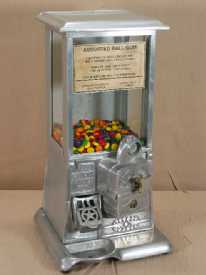
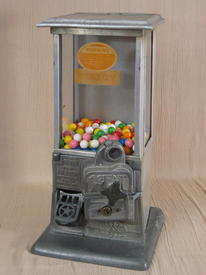
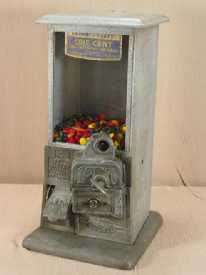
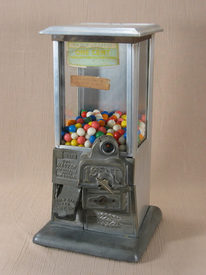
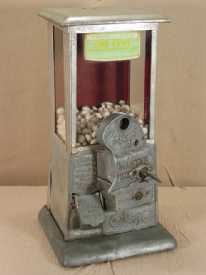
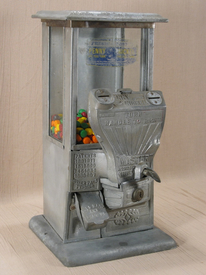
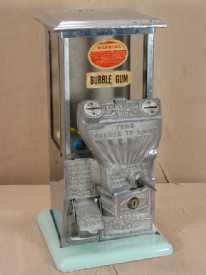
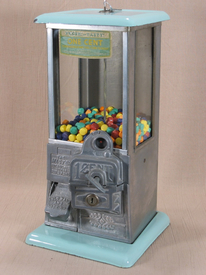
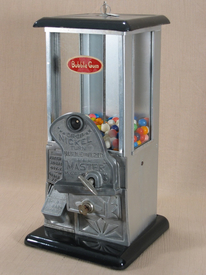
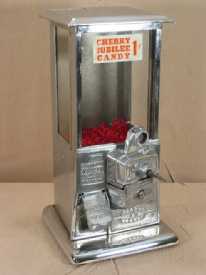
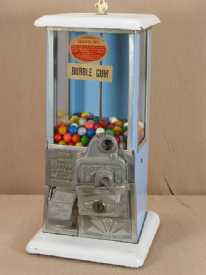
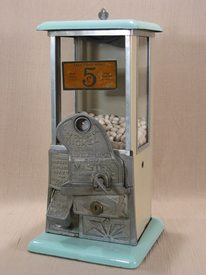
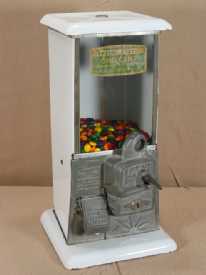
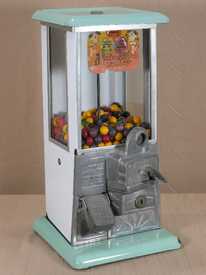
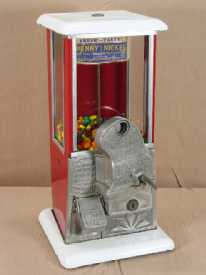
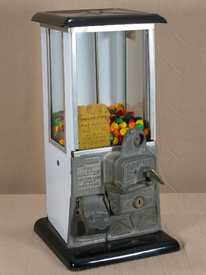
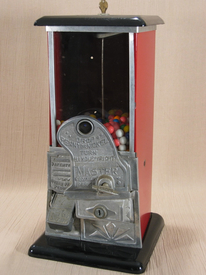
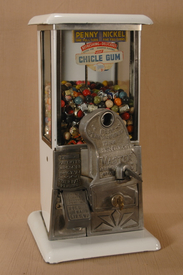
(Click on image to enlarge it)
Norris Manufacturing Company, Columbus, OH, c. 1922 through 1933, depending on model, 16". Like the Columbus A and Ford, Masters were produced for many years and evolved during the model's lifespan. The different versions have a lot in common, but can vary in key and easily-identifiable ways. All consist of a base, lid, cabinet, and mechanism. The major differences between eras and between individual machines include the material used to construct the base, lid, and cabinet; the finishes on these parts; the type of lid; and the type of mechanism and gate. By collecting permutations of these differences you could have a couple hundred Masters without duplication, and I know of several collectors who were headed that way until they came to their senses and scaled back or changed the focus of their collection.
The earliest Master was the "Star Door," nicknamed that for the open gate with a Columbus-like star stenciled in the center. This model had a 4-pronged handle and a base with a dish under the gate (see the 1st picture above for an example). The Star Door's base, cabinet, and lid were bare aluminum. Early Star Door Masters had "Patent Applied For" embossed above the gate. Mechanisms were penny-only or "nickel-penny" (but not "penny-nickel"---those came later, and not on Star Doors). A later transitional model exists that has the Star Door gate and the 4-pronged handle, but its faceplate is embossed with the patent date and the base doesn't have a dish (see the 2nd picture above for an example). A knowledgeable friend says that Star Door mechanisms on both versions differ from later mechanisms in subtle but definite ways. Star Doors of either type are not Officially Rare, but they're hard to find and are expensive when you finally do find one.
The next models also had a bare aluminum base, cabinet, and lid, but the open-stenciled gate had become a closed design without a star, the dish had disappeared, and the 4-pronged knob had flattened out. A patent date of "Aug. 14, 23" appeared above the gate of Novelty mechanisms, and that was joined by an additional patent date of Oct. 1924 above the gate of gooseneck mechanisms---more about these below. These models look like the later Master versions except for the all-aluminum construction, which I love, especially when it's gray and kinda crusty-looking and maybe just a little bent here and there---but just a little. The 3rd through 6th pictures show examples of models of this era. If these don't get your heart pumping a little faster, then you should stop reading here and jump over to a Columbus or Northwestern page.
At this point it gets harder to describe a chronology of models because they're so similar and because features overlapped, but here's how I think subsequent features evolved:
- Bases started as aluminum, then became nickel-plated or porcelainized cast iron or steel. I've seen machines with bare aluminum cabinets and green, black, or white porcelainized bases, so it seems that the bases evolved sooner than the bodies. Machines with bare aluminum cabinets and porcelainized bases can have bare aluminum slide-top lids or porcelainized steel lids that screw down onto a center rod or brace.
- Cabinets evolved from aluminum to steel that was painted, nickel-plated, or porcelainized. I don't know if the painted version was first or if it was available concurrently with the porcelainized cabinet. I'm sure that the nickel-plated steel cabinet was earlier than the porcelainized cabinet, but don't have a shred of evidence to support that assuredness.
- Early lids were bare aluminum and had a "slide-top" design. They slid into place from front to back along rails on the top of the sides of the cabinet, and locked into place in the back. I've also seen slide-top lids made of nickel-plated steel. Later lids were painted or porcelainized steel and attached to a center rod or center brace with a cylinder lock that screwed on through the center of the lid. Most screw-top lids had 4 raised lines that radiated out from the center to each corner, but some didn't. I think lids that don't have these raised lines are earlier versions, but I don't know that for sure. The angles aren't great, but you can see examples of both styles of lid in the pictures of porcelainized machines above, if you look for it.
- Mechanisms changed a little over the years. The main types were the following:
- The Star Door mechanisms, which as mentioned above differed in subtle ways from later mechanisms that looked similar. This was available as a penny-only, nickel-penny, and 1 cent 1-2-3 version. Most of these say "Patent Applied For" on the mechanism.
- A short penny-only mechanism, similar on the surface to the penny-only Star Door mechanism, but found on later models. A machine on which this is found is a "Master Novelty." They give one turn for a penny. These indicate a patent date of "Aug. 14, 23" above the gate.
- A penny-nickel gooseneck, which gives one turn for a penny and 5 turns for a nickel. These indicate patent dates of "Aug. 14, 23" and "Oct. 7, 24" above the gate.
- A penny-only gooseneck, which gives one turn for a penny. These indicate patent dates of "Aug. 14, 23" and "Oct. 7, 24" above the gate.
- A nickel-only gooseneck, which gives one turn for a nickel. These indicate patent dates of "Aug. 14, 23" and "Oct. 7, 24" above the gate.
- A "fantail" mechanism, patented in 1933, which contained an elaborate set of slug rejectors. According to Silent Salesmen Too these included a magnet to catch steel slugs, a hook to catch washers, a scale that returns improperly-weighted slugs, and a tilt mechanism that returns coins if the machine isn't level. The model with this mechanism was sold as the Model 77, but collectors simply call it a "fantail." It gives one turn for a penny and 5 turns for a nickel.
- A short, plain, penny-nickel mechanism that collectors usually associate with later Masters from the 1950s and maybe also the 1940s---but not me; to my mind this is a 1950s model but (again) I don't know that for sure. It looks like the penny-only Novelty mechanism, but where the Novelty mechanism says "1 cent," this version is blank. Like the other penny-nickel versions it gives one turn for a penny and 5 turns for a nickel. I've always seen these on porcelainized cases with red cabinets and black bases and lids, and have come to believe that's the only correct combination for this mechanism. Bill Enes in Silent Salesmen Too mentions that this version is "rarer" than the Novelty; I agree that it's much less common, but would not use any form of the word "rare" to describe this mechanism.
Some very early goosenecks had a tab lock on the mechanism cover, but this didn't last long and is considered scarce. See the 5th picture above for an example of this lock. Of the 3 types of gooseneck mechanism, the penny-nickel is by far the most common, followed by the penny-only and then the nickel-only, which is typically pretty scarce.
- Unlike, say, the Northwestern 33 Peanut or Simpson Vendor, which are always bulk vendors, or the Northwestern 33 Ball Gum or Bluebird 1-2-3, which are always gumball vendors, a Master could be either a bulk vendor or a gumball vendor depending on the vending wheel. Most were bulk vendors with quadrilateral pockets in the wheel to allow for small loose product, but some had round holes specifically for gumballs. Given the choice, most collectors choose a gumball version over a bulk version. I can't explain why they do but they do, and I do, too.
- Norris used 3 main designs on their coin doors. You can see the "wheat" design in the 1st picture, the "filagree" design in the 5th picture, and the "rising sun" in the 9th picture. I used to think that they were introduced and made in the order of filagree, then wheat, then rising sun, but I've since realized that I'm either wrong or there's a lot more overlap between them than I thought there was. The Star Door Masters shown above have the wheat design, and I have an all-porcelain green-and-tan, penny-nickel gooseneck Master with the filagree design, which based on patina and fit I believe is original to the machine. Those 2 facts alone refute my chronology. Further refutation comes from Silent Salesmen Too, which mentions that gooseneck Masters came with the filagree or rising sun decorations on the coin door, which dispels any idea that the filagree design came early and then went away.
Of the 3 designs, the filagree design is the hardest to find and is (therefore) considered the most desirable. I guess the only thing I'm sure about the chronology of these coin door designs is that the rising sun came last, since I've seen it only on all-porcelain machines.
Cabinets---especially porcelain cabinets---came in a variety of colors. Ignoring the all-aluminum cabinets and aluminum cabinets with slide-top lids, I've seen them in the following color combinations (given as the color of the body & the color of the base and lid): Red & black, tan & black, white & black, aluminum & black, tan & green, aluminum & green, white & green, red & green, red & white, blue & white, aluminum & white, and white & white. Of these, I know of only 2 red & green examples (the green on which was a rich darker green, not the bright lime green on other Masters), 2 white & green, 2 white & black, and 2 aluminum & white (the serial numbers on which differed by only 2, so I'd bet the farm that at least one more existed at some point). Blue & white is a beautiful combination, and while not rare it's hard to find, is among the most desirable color combinations, and brings a hefty premium when it sells.
The Fantail deserves its own category because it's so different. You can barely see the product window behind the mechanism. It's not rare but it's not common, and collectors covet it more than they do most other Master models except for the Star Door and perhaps the blue & white combination. I've seen fantail mechanisms that I know were original to the machine on nickel-plated steel cabinets with nickel-plated steel slide-top lids and green porcelainized bases, and I've seen one on an all-aluminum slide-top case---see the 6th picture above. I've also seen fantail mechs on porcelainized machines with tan cabinets and green bases and lids, and have seen enough of these to believe they're correct in that combination. I've seen a few fantails mechs on other colored porcelainized cases, but I don't know if the combinations were correct or whether they were swapped over by a collector.
Master variations include windowless sides and various vendor flaps. Nearly all Masters had 3 windows, so sides without windows are uncommon although not rare. Solid sides and vendor flaps enhance a machine's value.
The examples pictured above are 100% original except for several of the decals, and show a variety of body styles and materials, color combinations, and mechanisms, and differ in other little ways as well. They're arranged in approximate order of age, with the oldest first. Included in the progression are the following (some of which I've already described, so please forgive the redundancy):
- Two Star Door Masters---one a "full" Star Door with a dished baseplate and the "Patent Pending" faceplate, the other a later transitional version.
- Four early all-aluminum slide-top machines, 2 with penny-only Novelty mechanisms, one with a penny-only gooseneck and a locking faceplate, and the last with a Fantail mechanism.
- A Fantail with a porcelainized steel base and a nickel-plated steel cabinet and slide-top lid.
- Two examples of another transitional type, with an aluminum cabinet and porcelainized steel bases and porcelainized steel screw-down lids.
- A steel, chrome-plated cabinet, base, and slide-top lid. I think the chrome plating was original to the machine, but could never be 100% sure. If it was, then this is the only chrome-plated Master I've ever seen.
- Various examples of porcelainized Masters with screw-down lids and penny-only Novelty, penny-only gooseneck, nickel-only gooseneck, or penny-nickel gooseneck mechanisms.
These examples provide a good overview of Master's permutations, but they're not an exhaustive catalog of the Master's possibilities. One glaring omission, for example, is the later porcelainized model with a blank faceplate and penny-nickel mechanism. The reason it's not pictured is that I've never owned one---but they're out there.
If you're considering buying a Master, especially one with an unusual color combination, you should consider the following:
- The base is attached to the cabinet by 4 rivets, and these 2 components were never meant to be separated. Check the rivets to see if they look old. I've occasionally seen harder-to-find color combinations that someone created by removing the original base and attaching one from another machine, and then matching the lid to the base. The rivets are the key to detecting this. For example, Masters with tan cabinets and green bases and lids are common, and all-white Masters are far from rare. From those could be made a Master with a white cabinet and green base and lid, and a Master with a tan cabinet and white base and lid, both of which would be rare (and in the latter's case, the first of its kind as far as I know).
- Parts of mechanisms are sometimes interchangable between machines. If you're evaluating a Master with patina, check it carefully to see if the patina is consistent across the entire exterior. It doesn't have to match exactly because different aspects of machines can age differently, but even in that case you should be able to speculate reasonable explanations for the differences. For example, maybe the machine sat for years on route with the left side facing a window and the right side facing a store's interior; that could lead to differences but the machine should still look "right." If, on the other hand, the coin door is shinier than the mechanism cover right above it, and the interface between the 2 parts on the side shows an obvious difference, then one of the parts is not original to the machine. I've seen this many times and have inadvertently bought Masters with slight mismatches that I didn't notice at the time I bought them. Once I see the mismatch then I can never unsee it. I now inspect everything carefully to ensure that the patinas all reasonably match.
- Parts of mechanisms sometimes can't be swapped between machines. This is the converse of the caution above, and is important to know in case you're looking at a machine with, say, a great filagree coin door, you find yourself getting a little turgid betwixt the thighs, and think "Oh man, that would look friggin' awesome on the early penny-only gooseneck at home." Even if the patina matches perfectly you're taking a risk that it won't swap over, so be aware.
- If the machine's been buffed out then you don't have any information about originality. That's one reason I value old patinas, but some collectors like their aluminum to be shiny---the more mirror-like, the better. That's fine if you're one of those guys, but be aware of the information lost to the buffer.
___________________________________________________________________________________________
The section above describes general aspects of the Master line, with emphasis on "general." I know of one Master that doesn't fit those generalities, and which as far as I know is one of a kind. It has the same width and depth as a normal Master, but it's 25" tall versus 16" for a "normal" Master. The case is one piece of sheet metal with no welds, so it's not two machines cobbled together---it was factory-made to be taller. The pictures below show the whole machine, and also show 2 shots that focus on the middle part of the machine to show that the metal spanning the height is unbroken.
The machine's current owner speculates that it was designed for use in a busy location with a lot of product turnover, since peanuts become rancid after a while. It's the only example of this variation that I or anyone I know has ever seen or heard of.
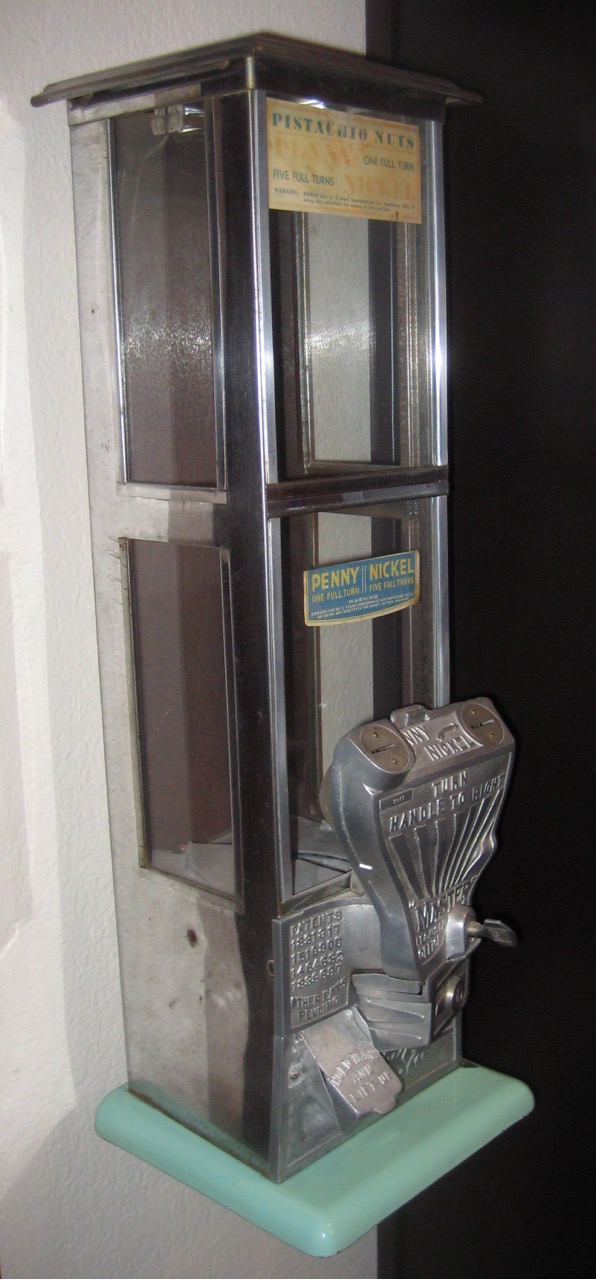
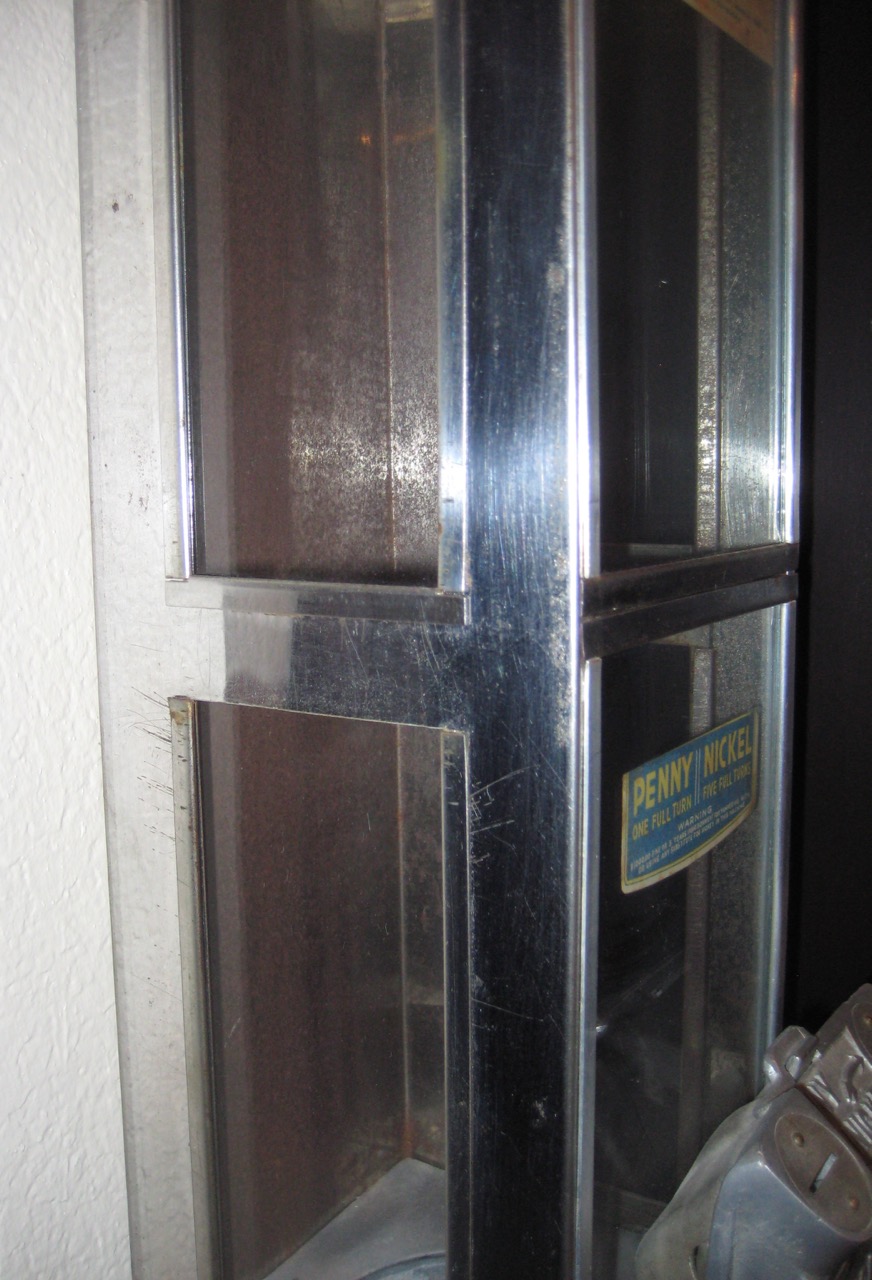
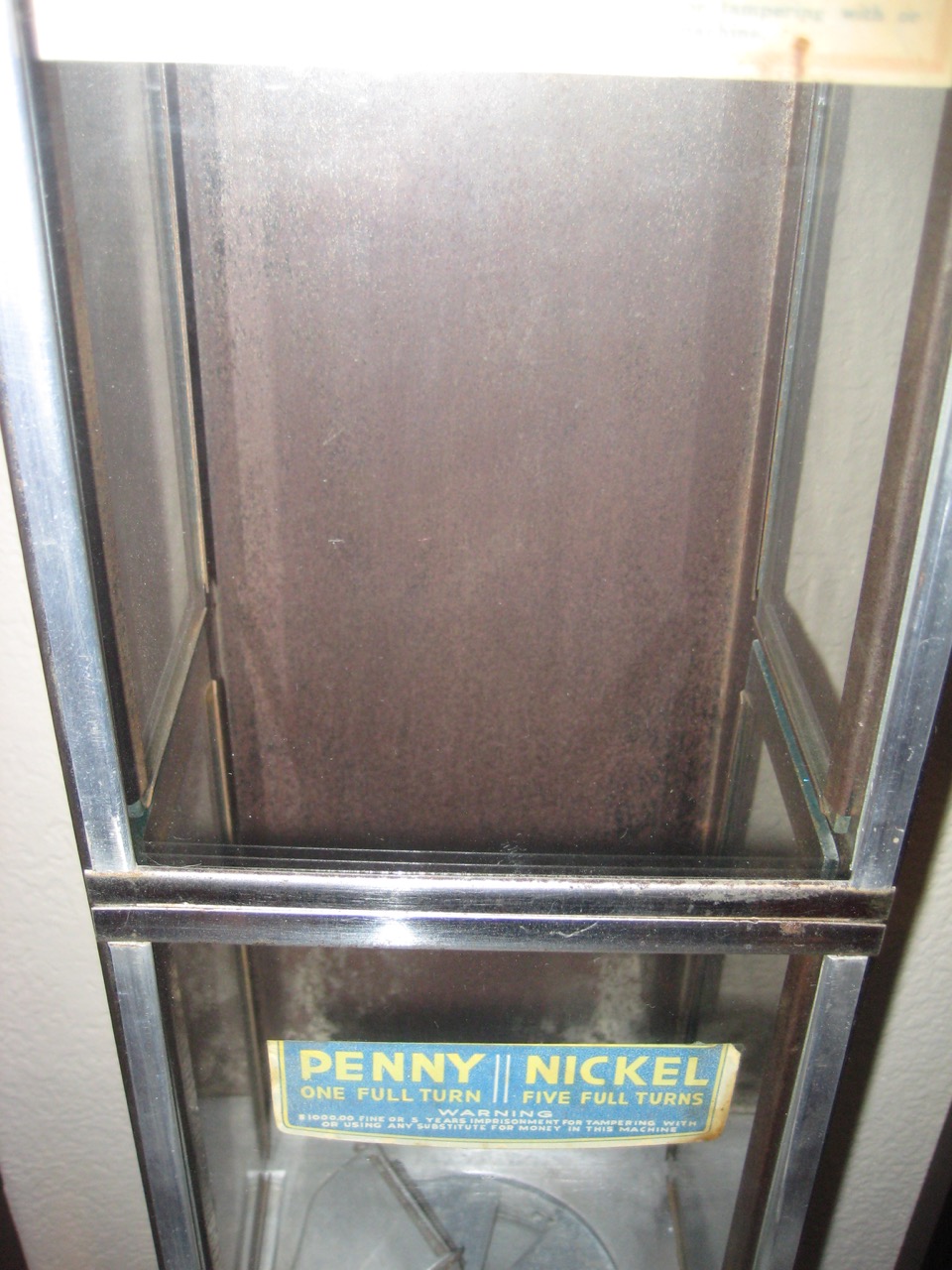
Thanks to Erick Johnson for the pictures of, and information about, his "double Master" Fantail.
___________________________________________________________________________________________
And finally....
I bought my first machine from Del Turk in Southern California in 1991. It was a restored Blue Regal, and I paid $125 for it. Some day it might be worth what I paid, but I'm not holding my breath. Anyway, I used to pepper Del with questions about machines because I knew nothing about them and had no reference source, but I was interested and enthused and wanted to learn. At one point in our conversations he mentioned a "Master" and I asked what that was.
He stopped and looked at me sternly, and said "You don't know what a Master is?" I meekly said "Uh, no." He said "Son, you're not a collector if you don't have a Master." He grabbed a book called Silent Salesmen, flipped through some pages, and then turned it around, pointed to a picture, and said "There's a Master."
I looked and cringed. It was hideous. I said, "If that's a Master then I guess I'll never be a collector. That thing's ugly."
I now have 11 as I update this page in February 2019, and that's after slowly scaling back a few over the past few years. For me, Masters were an acquired taste. Some collectors never acquire it, and some fall in love immediately and then feast on them almost exclusively. To each his own, but I never dreamed in 1991 that I'd have the Masters I have now. I'm not sorry it's worked out that way.
___________________________________________________________________________________________








___________________________________________________________________________________________
©Small Vintage Vending 2019


